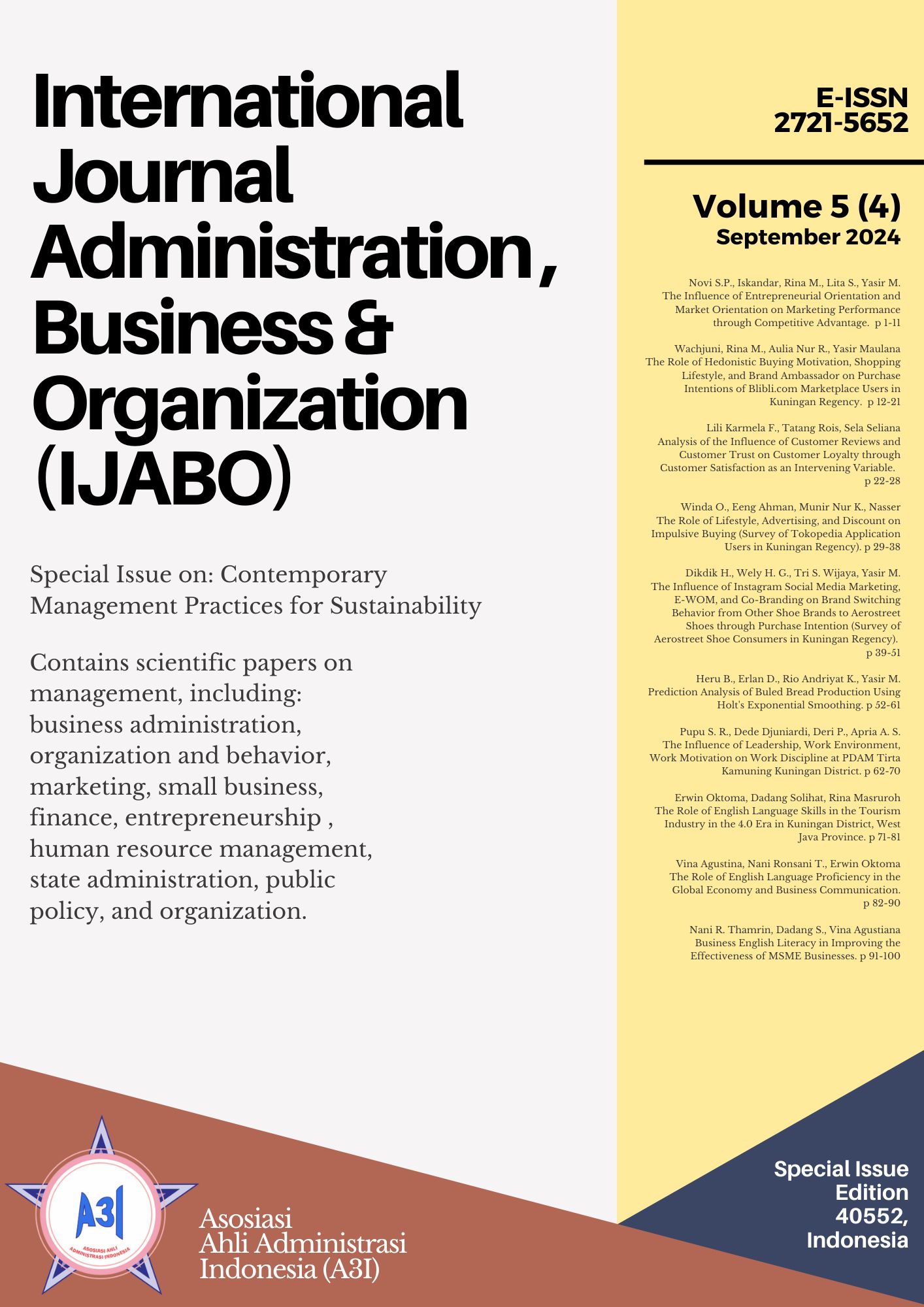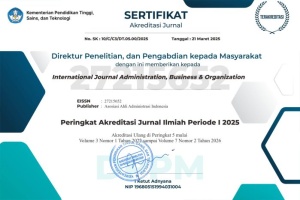The Influence of Instagram Social Media Marketing, E-WOM, and Co-Branding on Brand Switching Behavior from Other Shoe Brands to Aerostreet Shoes through Purchase Intention (Survey of Aerostreet Shoe Consumers in Kuningan Regency)
Abstract
This study aims to determine the direct and indirect influence of Instagram as social media marketing, electronic word of mouth and co-branding on brand switching behavior through purchasing interest in Aerostreet shoe products. Sample in this research were people who are consumers of Aerostreet shoes as many as 120 samples. questionnaire used as the research instrument containing statements and distributed via Google form. SEM AMOS ver. 23 used as data proccesed in this research. The results showed: Instagram social media marketing has a significant and positive impact on purchase intention. Electronic word of mouth has a positive and significant effect on purchase intention. Cobranding has a positive and significant effect on purchase intention. Purchase Intention has a positive effect on brand switching. Instagram social media marketing has no effect and insignificant on brand switching. Electronic word of mouth has no effect and insignificant on brand switching. Co-branding has no effect and insignificant on brand switching. Purchase Intention can mediate the influences of Instagram social media marketing on brand switchin. Purchase Intention can mediate the influences of electronic word of mouth on brand switching. Purchase Intention can mediate the impact of co-branding on brand switching.
References
Asnawi, A. (2021). Destination images: antecedents of city marketing, tourism event, and social media marketing concept. Jurnal Perspektif Pembiayaan Dan Pembangunan Daerah, 9(2), 171-186.
Anggraini, M. (2020). 15 Jenis-jenis Sepatu yang Banyak Digunakan, Perhatikan untuk Menunjang Penampilan Retrieved April 29, 2021,from https://m.merdeka.com/trending/15-jenis-jenis-sepatu-yang-banyak-digunakanperhatikan-untuk-menunjang-penampilan/
Ardhiansyah, A. N., & Marlena, N. (2021). Pengaruh social media marketing dan e-wom terhadap minat beli produk geoffmax. AKUNTABEL, 18(3), 379-391.
Arraniri, I., Maulana, Y., Komarudin, M. N., & Gunawan, W. H. (2024). The Influence Of Financial Performance On Returns With Esg As An Intervening Variable. International Journal of Economics, Business and Accounting Research (IJEBAR), 8(2).
Assael, H. (2004). Consumers Behavior and Marketing Action, Edisi 3, South Western College. Publishing.
Chang, Wie-Lun. (2009). Roadmap of Co-Branding Positions and Strategies. The Journal of American Academy of Business, Cambridge. Vol. 15. No.1.
Charo, N., Sharma, P., Shaikh, S., Haseeb, A., & Sufya, M. Z. (2015). Determining the impact of ewom on brand image and purchase intention through adoption of online opinions. International Journal of Humanities and Management Sciences, 3(1), 41-46.
Chatrin., & S, Karlina. (2006). Analisa Faktor - Faktor Yang Mempengaruhi Konsumen Dalam Melakukan Brand Switching Terhadap Bread Boutiques Di Supermall Pakuwon Indah Surabaya. (Doctoral dissertation). Universitas Kristen Petra, Surabaya, Indonesia.
Darmawan, E., Yusuf, F., Suseno, E., Budianto, H., & Maesyaroh, S. (2021, June). Decision support system for the selection of exemplary teachers using profile matching method. In Journal of Physics: Conference Series (Vol. 1933, No. 1, p. 012013). IOP Publishing.
Daugherty, T., & Hoffman, E. (2014). eWOM and the importance of capturing consumer attention within social media. Journal of Marketing Communications, 20 (1-2), 82-102.
Dickinson, Sonia and Alison Barker. (2007). Evaluations of Branding Alliances Between Non-Profit and Commercial Brand Partners: the Transfer of Affect. Wiley Inter Science, Vol. 12, 75-89.
Fitriani, L. K., & Wulandari, L. (2021). Organizational Citizenship Behavior in the Construction of Islamic Boarding School: A Structural Model. Jurnal Minds: Manajemen Ide Dan Inspirasi, 8(1), 141-154.
Ganesh, J., Arnold, M. J., & Reynolds, K. E. (2006). Understanding the Customer Base of Service Providers: An Examination of the Differences between Stayers and Switchers. Journal of Marketing, 64(3), 65–87.
Gunawan, W. H., & Wachyuni, W. (2020). Information Technology and Market Orientation on the Competitiveness and Performance of a Kuningan's Tourism Activity. Jurnal Minds: Manajemen Ide dan Inspirasi, 7(2), 105-116.
Gunelius. (2011). 30-Minute Social Media Marketing. United States: McGraw-Hill Companies.
Harjadi, D., & Fatmasari, D. (2017). Implementation of Integrated Marketing Communication in Image of Private Higher Education. TRIKONOMIKA, 16(2), 63-67.
Harjadi, D., & Gunardi, A. (2022). Factors affecting eco-friendly purchase intention: subjective norms and ecological consciousness as moderators. Cogent Business & Management, 9(1), 2148334.
Harjadi, D., & Nurfatimah, S. (2021). Brand Switching Behavior From Samsung To Oppo Among Millenials. Trikonomika, 20(1), 41-46.
Harjadi, D., Fatmasari, D., & Hidayat, A. (2023). Consumer identification in cigarette industry: Brand authenticity, brand identification, brand experience, brand loyalty and brand love. Uncertain Supply Chain Management, 11(2), 481-488.
Harjadi, D., Suhardi, D., & Ayisiyah, N. (2019). Electronic-Word of Mouth and Product Quality on Buying Interest Through Trust in Online Shops. Trikonomika, 18(2), 74-79.
Hasibuan, L. (2018). Peminat Sneakers di Indonesia Naik 70%. Retrieved February 7, 2021, from https://www.cnbcindonesia.com/lifestyle/peminat-sneakers-diindonesia-naik-70
Husna, L. N. (2020). Pengaruh Co-Branding Dan Brand Equity Terhadap Purchase Intention Pada Produk Indomie Hype Abis Dengan Brand Preference Sebagai Faktor Mediasi Dan Tinjauannya Dari Sudut Pandang Islam:(Studi Empiris Pada Mahasiswa Fakultas Ekonomi dan Bisnis Universitas YARSI) (Doctoral dissertation, Universitas YARSI).
Imamah, L. F., & Hidayat, R. (2020). Pengaruh Co-Branding Terhadap Purchase Intention Melalui Brand Equity Pada Produk Indomie Hype Abis Chitato. Ilmu Manajemen, 95.
Jahidah, N., Sofyan, M., & Suteja, J. (2024). External And Internal Banking Factors On The Intermediation Function Of State-Owned Banks. Jurnal Riset Bisnis dan Manajemen, 17(2), 1-16.
Jalilvand, M. R., & Samiei, N. (2012). The impact of electronic word of mouth on a tourism destination choice: Testing the theory of planned behavior (TPB). Internet research, 22(5), 591-612.
Keller, Kevin L. (2008). Strategic Brand Management Third Edition. New Jersey: Pearson Education International
Khasanah, A. U., & Kuswati, R. (2014). Analisis faktor-faktor yang mempengaruhi perpindahan merek pada produk smartphone. Benefit: Jurnal Manajemen dan Bisnis, 17(2), 123-131.
Kim, W Chan dan Renee Mauborgne. 2006. Blue Ocean Strategy (Strategi Samudra Biru): Ciptakan Ruang Pasar tanpa Pesaing dan Biarkan Kompetisi Tak Lagi Relevan. Penerbit Serambi, Jakarta.
Kotler, P and Kevin L Keller. (2012). Marketing Management. 14th Edition. Pearson, United States of America.
Kotler, P., & Keller, K. L. (2012). Prinsip-Prinsip Pemasaran. Edisi 12. Jakarta: Erlangga.
Manalu, V. G., & Adzimatinur, F. (2024). How Digital Transformation Can Affect Product Innovation Performance MSMEs: Evidence from West Java. Jurnal Aplikasi Manajemen, 22(1), 253-266.
Maulana, Y., Yusuf, A. A., Dirgantari, P. D., & Hurriyati, R. (2023). Marketplace Strategic Positioning Analysis. Al-Amwal: Jurnal Ekonomi dan Perbankan Syari'ah, 15(1), 101-111.
Nikmah, F. (2017). Kajian Tentang Pemasaran Online untuk Meningkatkan Peluang Bisnis. Jurnal Administrasi Bisnis, 11(1), 47–56.
Park, C Whan, Sandra Mildberg dan Robert Lawson. (1991). Evaluation of Brand Extension: The Role of Product Feature Similarity and Brand Concept Consistency. Journal of Consumer Research, 18 (2), 185-93.
Peter, J. Paul dan Jerry C Olson. 2000. Consumer behavior: Perilaku Konsumen Dan Strategi Pemasaran. Jilid 1. Edisi Keempat. Jakarta: Erlangga.
Rahmantya, Y. E. K., & Djazuli, A. (2019). Hospital’s competitive advantage through service quality, information systems and Islamic work ethics. Problems and Perspectives in Management, 17(2), 193.
Safitri, A., & Septrizola, W. (2019). Pengaruh Dissatisfaction, Variety Seeking, Electronic Word of Mouth, dan Religiosity terhadap Brand Switching Produk Kosmetik Lain ke Kosmetik Wardah pada Mahasiswi Universitas Negeri Padang. Jurnal Kajian Manajemen Dan Wirausaha, 1(01), 26-35.
Saleh, C. (2020). Konsep, Pengertian, dan Tujuan Kolaborasi. Pustaka Universitas Terbuka, 1.
Setiadi, A. (2016). Pemanfaatan media sosial untuk efektifitas komunikasi. Cakrawala: Jurnal Humaniora Bina Sarana Informatika, 16(2).
Shafitri, S., & Anggraeni, T. (2020). Analisa Strategi Co-Branding Smitten By Pattern Pada Sebelum dan Selama Pandemi COVID-19. Journal Komunikasi, 11(2), 159168.
Silitonga, L. T. (2018). PASAR SEPATU: Ini Dia Merek yang Jadi Raja Pasar. Bisnis.Com.
Simarmata, E. F. (2019). Pengaruh Electronic Word Of Mouth Terhadap Citra Merek Dan Perpindahan Merek (Survey Pada Pengguna Smartphone Samsung Ke Vivo Di Universitas Hkbp Nommensen Medan).
Siregar, Z. M. E., Masruroh, R., Syamsuri, A. R., Jaya, R. I. K., & Adam, D. H. (2022). Locus of Control on Pro-Environmental Behavior: The Role of Attitude toward Pro-Environmental Behavior. International Journal of Social Science and Business, 6(3), 416-425.
Solihin, D. (2020). Pengaruh kepercayaan pelanggan dan promosi terhadap keputusan pembelian konsumen pada online shop mikaylaku dengan minat beli sebagai variabel intervening. Jurnal Mandiri: Ilmu Pengetahuan, Seni, Dan Teknologi, 4(1), 38-51.
Sugiyono. (2017). Metode Penelitian Kuantitatif. Alfabeta.
Sumarwan, U. (2015). Perilaku Konsumen (2nd ed.; R. Sikumbang, Ed.). Bogor: Ghalia
Vinerean, S., Cetina, I., Dumitrescu, L., & Tichindelean, M. (2013). The Effects of Social
Waluyo, M. (2016). Mudah Cepat Tepat Penggunaan Tools Amos Dalam Aplikasi (SEM). UPN Jatim, 14–27.
Washburn, J. H., Till, B. D., & Priluck, R. (2000). Co‐branding: Brand equity and trial effects. Journal of consumer marketing, 17(7), 591-604.
Wicaksono, C. A. (2019). Pengaruh Customer Satisfaction, Switching Cost, Dan Trust In Brand Terhadap Customer Loyalty (Studi Pada Pengguna Kartu Perdana Telkomsel di Kota Malang). Jurnal Ilmiah Mahasiswa FEB, 8(2).
Wiguna, R. (2022). Pemasaran Media Sosial dan Harga terhadap Loyalitas Merek Dimediasi Minat Beli pada Konsumen Jasa Kurir. Jurnal Impresi Indonesia, 1(5), 485-501.
Yunengsih, W., Sopiyan, P., & Masruroh, R. (2023). The Effect of Hedonic Shopping Motivation and Shopping Lifestyle on User Impulse Buying Shopee E-Commerce (Study on Majalengka University Students). Finance and Business Management Journal, 1(1), 13-27.
Copyright (c) 2024 Dikdik Harjadi; Wely Hadi Gunawan; Tri Sukma Wijaya Wijaya

This work is licensed under a Creative Commons Attribution-ShareAlike 4.0 International License.
Authors who publish in this journal agree to the following terms:
- The authors confirm that they are the authors of the submitted article, which will be published (online) in the journal IJABO (International Journal Administration, Business & Organization) by the Asosiasi Ahli Administrasi Indonesia (A3i), Bandung, Indonesia. The author’s name will be evident in the article. The publisher makes all decisions regarding the layout and distribution of the work.
- Authors guarantee that the work is their own original creation and does not infringe any statutory or common-law copyright or any proprietary right of any third party. In case of claims by third parties, authors commit themself to defend the interests of the publisher and shall cover any potential costs.
- Authors retain copyright and grant the journal the right of first publication, with the work simultaneously licensed under a Creative Commons Attribution-ShareAlike 4.0 International License (CC BY-SA 4.0). This license allows the redistribution and reuse of papers provided the authorship is properly credited.
- Authors can enter into separate, additional contractual arrangements for the non-exclusive distribution of the journal's published version of the work (e.g., posting it to an institutional repository or publishing it in a book), with an acknowledgment of its initial publication in this journal.
- Authors are permitted and encouraged to post their work online (e.g., in institutional repositories or on their website) prior to and during the submission process, as this can lead to productive exchanges and earlier and greater citations of published work.

















